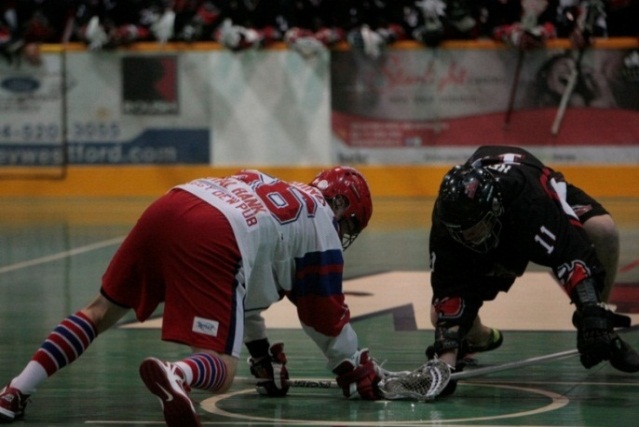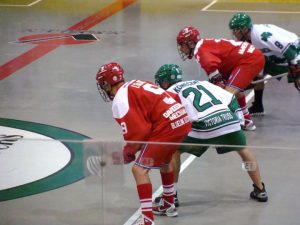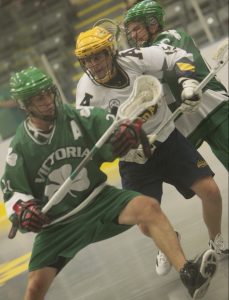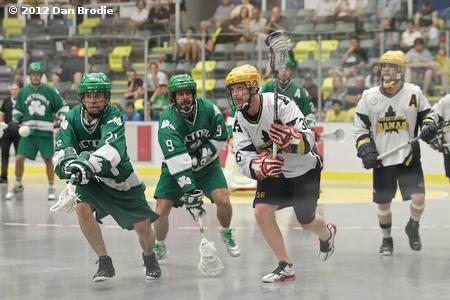
Fundamental Skills Analysis:
Loose Balls:
- The team that wins the most loose ball battles usually ends up winning the game. More loose balls (also known as "ground balls" in field lacrosse) translates into more possession, which usually significantly affects other variables such as: momentum, multiple re-sets, shot totals and fatigue.
There are 4 movement patterns that are generally used when picking up the ball: "scoop on-the-run," "trap & scoop," "scoop-tuck-and-turn," "scoop-to-triple-threat."
When “scooping” the ball be sure to get low to the ground (crouched), getting “2 butt’s low,” that being the butt of the player (knees bent), and the “butt-end” of the stick. If the player is holding the stick “left-handed” then their left foot should be forward (beside the ball - which protects it from opponents), sliding the top hand down to the "throat" of the stick where possible, with the “head” of the stick scooping the ball on the opposite side of their body. The "scoop" is a shoveling action done in one fluent motion while "running through the ball," aiming the mouth of the stick a few inches behind the ball; “corralling” it once obtained. The next thing to do after obtaining the ball in a game would be to read the situation, either "tucking it in" and running to "open space" (away from pressure), or immediately getting it up into the "triple threat" position ready to make a play with the ball.
The “trap and scoop” is a method of picking up the ball in which the player puts the back of the stick-head over the ball and pulls it in toward themselves, followed by the above mentioned scooping action to pick it up. This technique works best in “scrums” when multiple players are “battling” for the loose ball; it can also be used by beginners that are struggling to pick up the ball. Communication in scrums is also vitally important in obtaining the loose ball. Sometimes players' feet are also useful in keeping a loose ball scrum "alive," or when a player loses their stick and has to kick the ball to a teammate.
Always run into (through) the ball, don’t wait for it to arrive ("attack the loose ball"). Player’s should do their best to keep the ball in front of them and pick the ball up with two-hands on the stick once they arrive at it, scooping it "on-the-run" where possible. A 2-handed scoop is a must for even the most experienced players (“two-hand tough”).
*The biggest determining factor in getting a loose ball is hard work/effort. Battling to keep the ball alive for a teammate is just as important as picking the ball up oneself.
Face-Offs:

-
- Face-Off/Draw (See Games Drill #6): The start of the game, the start of each period, and after every goal, the play begins with a face-off (also known as a “draw”). Each face-off begins with two players at the “face-off dot” (inside of the restraining lines), with their right shoulder’s facing their own "goal/net" (advantage righty's).
Their sticks need to be flat on the ground, with their stick “pockets” in a back-to-back position (pockets/mesh "pushed in," as to not obstruct the starting position of the ball between the two sticks). The ball is then placed between the two sticks (without touching & straight - not tilted) and on the whistle the players first motion must be to pull straight back, utilizing their body weight, quick reactions, and artful stick manoeuvres to try and work the ball free, gaining possession for their team.
The rest of the players on each team must stand outside of the restraining lines (usually a balanced number on both sides) where players are free to move until the whistle is blown (or until the ref instructs them to stop), and the ball leaves the face-off dot. Most coaches will study where the ball is going on the first few face-offs and then make adjustments accordingly.
-
-
- Face-Off Stance: Face-off-takers should be strong (top heavy), flexible, with quick hands & reactions, endurance, agility and “pursuit.” The stance a player chooses is an individual preference but a well-balanced position with weight (centre of mass) slightly over the ball (crouched) and hands spread wide, is best practice.
-
The stance of a player should also not reveal their intended move/tactic, as multiple moves (clamp, half-clamp tie-up, screw-driver plunger, etc.) are usually needed based on teams making “adjustments” to the other team’s face-off tendencies.
Good face-off-takers will keep their eyes up while facing-off, keeping an eye on the referee while trying to get a sense for the “timing” of their cadence.
Once the whistle blows, face-off-takers are supposed to pull straight back but often first use their arms/legs in a quick and powerful punching motion forward to gain leverage, pulling back when instructed to by the referee.
All players on the loose ball team should be in the “athletic position,” eyeing the face-off-dot for when they are able to cross the restraining (rag) lines and pursue the ball.
-
-
-
- Face-Off Execution: Depending on the situation and the quality of the opposing face-off-taker, teams will usually play two players on the defensive side and two players on the offensive side of the ball.
-
-
Face-off-takers should be careful not let the opposing face-off-taker get a fast-break on their own net, doing their best to get on the defensive side of the opposing face-off-taker if they lose the draw (chasing for a trail check if necessary).
Where a team is continually winning the face-off to the same spot on the floor, the opposing team should adjust and try to pursue that area with multiple players and/or in a strategic way. Placing two teammates on the restraining-line side-by-side (foot to foot) is one way of taking control of these “hot spots.” After players are “set,” the referee’s whistle is then blown to the cadence of “down, set, “(whistle)” and the “face-off” commences, usually with some sort of scrum. Quick hands and anticipation are great assets for face-off-takers, although if they make a move after the ref says “set” and before the whistle (early), it is a loss of possession.
For players behind the restraining lines, a quick slash on the gloves, hook or “bump” is often enough to get a head-start on their check; but they too need to make sure they don’t go over the line before the ball exits the face-off circle, otherwise it is also a loss of possession. Players need to either pick up the ball themselves or do their best to keep the ball alive for a teammate by communicating, boxing-out their “check,” throwing a "body check," setting a pick or being an outlet.
Teams need to be aware of quick, advantageous line changes, where one player may actually line up near the “defensive door” of the players bench and send an offensive player out (“long change”) quickly, upon possession of the ball (otherwise known as a “32”). It is important to identify personnel and understand the “situation” to be effective on face-offs. When down a few goals on the game clock, teams may put three players on the offensive side of the face-off circle; usually more offensive-minded players. Always note who you are playing against.
The players on the defensive side of the face-off circle should “hold the line” and not allow any opposing players behind them (held accountable). Generally speaking, all players have the responsibility of eliminating “fast-breaks” and goals against. A face-off goal against is always devastating for a team.
When trying to create fast-breaks off of a face-off, the first place to look after getting the loose ball should be to the far-side and/or up-floor on a “lead” outlet-pass. If a team has a premiere face-off-taker, or is down a few goals late in the game, teams may also choose to put two offensive specialists down by the opponents net prior to the face-off. This type of offensive strategy forces two defenders to have to cover these offensive players back in the defensive zone and allows the face-off-taker more time & space to pick up the ball themselves, which often creates “fast-break” opportunities.
-
- *Face-offs can be practiced against nobody; against the boards; against an opponent; with distractions.
- *Face-offs can be practiced with a verbal cadence only, or visual cadence only; steady whistle (predictable) or unsteady whistle (unpredictable).
- Categories: Beginner / Loose Ball / Free / Drillbook



